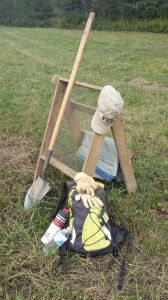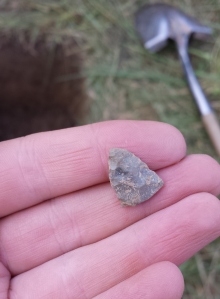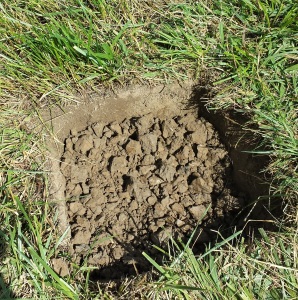For the past couple of weeks I’ve been working with IUP Archaeological Services on a small project in Indiana County, Pennsylvania. The project was a survey that we were conducting to identify cultural resources in an area that will soon be subject to development. This type of archaeology is called cultural resource management, or CRM, and it is a little different than the archaeology I’ve written about in the past. Unlike the large scale, long term field projects I have usually worked on, CRM is done when a development project such as a road or building that is carried out or funded by the Federal government has the potential to damage or destroy a cultural resource.
There are three types of archaeological surveys that may be conducted on a CRM project. Phase I surveys are the first type, and they aim to identify whether or not cultural resources exist in the proposed project area. This survey may involve surface collection, geophysical investigation, and the excavation of shovel test pits. If cultural resources are identified in this survey, Phase II testing may be conducted. This typically involves the excavation of test units and is meant to assess whether the resource is eligible to be included on the National Register of Historic Places. A Phase III excavation is conducted if the resource is considered eligible, and involves mitigation or data recovery. CRM is the most common form of archaeology conducted in the United States, and it plays an important role in the identification and documentation of archaeological sites across the country.
The project I’ve been working on is a Phase I survey where we dug 35 shovel test pits, or STPs. These were 50 centimeter squares, spaced 15 meters apart along three transects, and each were dug until we were at least 10 to 20 centimeters into subsoil. After we finished the first round of test pits, we excavated additional ones around the STPs that had artifacts in them. These are called radials, and they are meant to establish whether additional cultural material exists in that area.
Our project area was in a grassy field surrounded by trees and creeks, and no prior archaeology had been done at this location. I was very eager to get started, as this was my first time working on a CRM project. We spent a total of four days in the field, and each day provided new lessons and surprises. We began by establishing where we were going to dig using a GPS unit and marking the places we needed to excavate with pin flags. Then, we got to work!
The first day had three big surprises. The first was the soil. It was terrible. Indiana hadn’t had rain for a while leading up to the project, so the dense clay soil in this particular area was extremely hard to break up and screen. In fact, we broke two screens in the first few hours just trying to get through it! The second surprise was a thunderstorm that hit in the afternoon, forcing us to wait in the van until it passed. Fortunately, this softened up the soil a bit, which allowed us to more easily reach our third surprise of the day – the tip of a stone tool found in one of my STPs! This was very exciting, and I was eager to return later in the week to dig some more.
The second day had one big surprise which resulted in very little progress. We arrived at the site to find that the pin flags had been mowed down by a farmer who apparently used the grass in that particular field to feed his cows. This also happened to be the day when our project director was out of town with the GPS unit, so in the interest of maintaining consistency with our grid, we chose to wait until the next day to re-establish the grid and continue excavating. The next couple of days were far more productive, as we continued to dig and found a number of prehistoric stone tools and flakes, which were mostly concentrated in one part of the project area. This indicates that there was definitely some kind of cultural activity at that location, which is exactly what we were trying to find out.
Last week, we wrapped up our fieldwork and have since begun writing the report. My responsibilities are now to clean and analyze the artifacts we found and to write up a section of the report that will be sent to a number of people, including the client who is developing on the land. I’m excited about the artifact analysis, as we found some very interesting material during our excavation! I’m also happy that I get to contribute to the final report, as that will provide me with valuable experience in a very important step of any archaeological project.
This project was a great learning experience at a neat site and I’m very glad that I was a part of it! As my work with Archaeological Services winds down, however, my semester is just starting to pick up speed. The most exciting development is that my thesis research is now officially underway. I finally had the chance to visit my site yesterday, and I will be writing about that and my project later this week!




